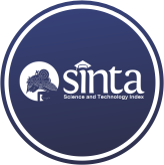Rancang Bangun Aplikasi Verifikasi Keaslian e-Sertifikat dengan Algoritma SHA-512
(1) Universitas Ciputra Surabaya, Surabaya, Indonesia
(2) Universitas Ciputra Surabaya, Surabaya, Indonesia
(*) Corresponding Author
Abstract
Full Text:
PDFReferences
S. Chao, Z. Chen, and X. Sun, "Anti-Counterfeit Authentication System of Printed Information Based on A Logic Signing Technique," Atlantis Press | Atlantis Press Open Access Publisher Scientific Technical Medical Proceedings Journals Books, Oct. 2007. [Online]. Available: https://www.atlantis-press.com/article/1429.pdf.
O. Ghazali and O. S. Saleh, "A Graduation Certificate Verification Model via Utilization of the Blockchain Technology," Journal of Telecommunication, Electronic and Computer Engineering (JTEC), Sep. 26, 2018. [Online]. Available: https://jtec.utem.edu.my/jtec/article/view/4707/3640.
C. R. Dougherty, "CERT/CC vulnerability note VU#836068," CERT Vulnerability Notes Database, Dec. 31, 2008. [Online]. Available: https://www.kb.cert.org/vuls/id/836068.
B. Schneier, "Cryptanalysis of SHA-1," Schneier on Security, Feb. 18, 2005. [Online]. Available: https://www.schneier.com/blog/archives/2005/02/cryptanalysis_o.html.
NIST, "NIST.gov - Computer security division - Computer security resource center," Wayback Machine, Apr. 12, 2011. [Online]. Available: https://web.archive.org/web/20110625054822/csrc.NIST.gov/groups/ST/toolkit/secure_Hashing.html.
M. Stevens, E. Bursztein, P. Karpman, A. Albertini, and Y. Markov, "The first collision for full SHA-1," [Online]. Available: https://shattered.io/static/shattered.pdf.
A. Argani and W. Taraka, "Pemanfaatan Teknologi Blockchain Untuk Mengoptimalkan Keamanan Sertifikat Pada Perguruan Tinggi," Google Books, Jun. 2020. [Online]. Available: https://books.google.co.id/books?hl=en&lr=&id=cDILEAAAQBAJ&oi=fnd&pg=PA10&dq=sertifikat+palsu&ots=a0GNYjgrzy&sig=IdZpKZYgJEzII0Xr9B6nOdjSoYY&redir_esc=y#v=onepage&q=sertifikat%20palsu&f=false.
U. Rahardja, E. P. Harahap, and G. Fresandy, "Penerapan Sistem Autentikasi Sertifikat Sebagai Pengambil Keputusan Validasi Sertifikat Pada Perguruan Tinggi," iLearning Journal Center (iJC), Aug. 2017. [Online]. Available: https://ijc.ilearning.co/index.php/TMJ/article/view/312/25.
A. H. Lone and R. Naaz, "Forgery Protection Of Academic Certificates Through Integrity Preservation At Scale Using Ethereum Smart Contract," Scalable Computing: Practice and Experience, Dec. 2020. [Online]. Available: https://scpe.org/index.php/scpe/article/view/1806/672
DOI: http://dx.doi.org/10.30645/j-sakti.v7i2.664
Refbacks
- There are currently no refbacks.
J-SAKTI (Jurnal Sains Komputer & Informatika)
Published Papers Indexed/Abstracted By:
Jumlah Kunjungan :











